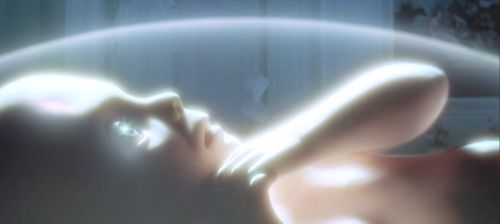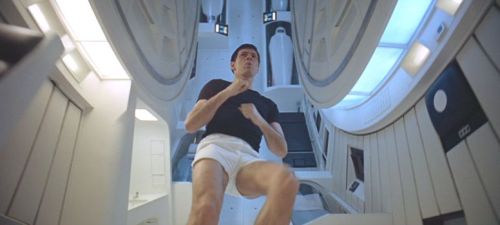2001: A Space Odyssey (Stanley Kubrick, 1968)
The popular remembrance of the reception to Stanley Kubrick’s 2001 is of a generation of hip, pot-addled college students letting the sound and light show wash over them, and then arguing long into the night about the film’s meaning. In 1969 the veteran science fiction writer Harlan Ellison sarcastically complained about acquaintances boring him at 3am with lengthy treatises on the film’s commentary on “the philosophy of the Vedantist movement, and the incredibly brilliant tour de force of Nietzsche-esque subplotting Kubrick pulled off.” Critics’ reviews at the time alternated between those hailing a masterpiece and those deriding the film as a pretentious con.
As much as it would have been fun to have been part of that initial wave of appreciation, looking back it’s hard to see what was so puzzling about 2001. While the film has never quite shaken its reputation for inscrutability, watching it today there’s nothing so mysterious about it. Not only have there been many more genuinely obtuse science fiction films since (starting with Andrei Tarkovsky’s Solaris in 1972), but the basic themes and devices of Kubrick’s film have been so absorbed into the genre that they now seem like familiar standards. Yet 2001 hasn’t been reduced by this process: if anything, that increasing comfort with its message and approach has defused the criticism of those who would dismiss it as a pretentious think-piece. And when we no longer characterise it as a giant-budget art film, it’s easier to appreciate its grandeur on its own terms and also to discern its lasting impact on a wider front.
Kubrick had approached science fiction writer Arthur C. Clarke in 1964 suggesting they collaborate on a science fiction film, and the nature of the pitch he gave Clarke tells us a lot about Kubrick’s increasing artistic ambition in the wake of Dr Strangelove. His conception was still vague in its specifics, but he knew he wanted to make an awe-inspiring work about humanity’s relationship with the universe. It was a conception that sought to be both “Intellectual” and “Epic” in an age where the closest Hollwood had come to either in science fiction was the Monster of the Id battling it out with Dr Morbious in Forbidden Planet (1956).
The idea they ultimately emerged with stole elements from Clarke’s novel Childhood’s End and his short story “The Sentinel,” and was so ambitious it risked being comical. The film’s events bookend the entirety of human history, starting with a depiction of a tribe pre-human monkeys, who are close to extinction until an alien force imbues them with intelligence and aggression. Flash-forwarding past all recorded history (through a celebrated match-cut), Kubrick then shows the human race leaving earth and venturing to the stars, where one of its representatives encounters the same alien force and – in the film’s only genuinely puzzling sequence – transcends his human form to be reborn as a new post-human consciousness.
That this is the intended meaning of the film is not in doubt; Arthur C. Clarke’s novel, written concurrently with his collaboration on the screenplay, sets the scenario out in dull, completely unambiguous terms. But the contrast between the effect of the film and the novel is telling about Kubrick’s instincts for the material versus Clarke’s. The difference is mostly one of self-awareness. Clarke wrote bland characters because they were the only characters he knew how to write, but Kubrick is astute about their bloodlessness, which lets him turn a deficiency of Clarke’s writing into a thematic point.
This might sound like a lame excuse for poor characterisation – I can hear Ellison’s derisive snort as I write – but Clarke’s real love was always for the science behind the future worlds he envisioned. Kubrick no doubt shared a fetish for getting the technical details right, but in the film that simply results in a world that feels instantly real and convincing (which helps ground us after the huge leaps through time we take). Unlike Clarke, who in his novel seems to believe his astronauts are engaging characters, Kubrick contrasts inspires wonder in his audience with wondrous visuals but then invites us to note the impassive response of the film’s characters. So scientist Heywood Floyd treats the trip to the moon as the dullest of long distance flights, while the Jupiter mission crew members David Poole and Frank Bowman seem almost comatose as they venture on the extraordinary journey to Jupiter. These are scientists responding in a clinical fashion to extraordinary events, and while Clarke’s novel shares and endorses that scientist’s perspective, Kubrick sees the deadness of it. At the start of the film we saw the monkey-people nudged into science and primitive warfare, which allows them to progress a rung up the evolutionary ladder; Kubrick (unlike Clarke) shows that advance played to its end point, with technology having leached the humanity out of the characters, and the world locked in a tense cold war stand-off.
It is in this context that we get the intensely sympathetic portrayal of Hal the computer. It is frequently noted that Hal is by far the most sympathetic character in the movie, but again, in Clarke’s conception the computer is only separated from the astronauts by the fact that he goes bonkers. In the film, Hal exists as a warmer contrast to the humans; the people are at the end of their evolutionary journey, with the machines they created more human than they are. It’s a genuinely wrenching moment when Bowman has to “kill” Hal, and Hal goes from pleading for his life to a childlike recitation of nursery rhymes. Kubrick’s reputation as a cold, passionless filmmaker is deserved, but 2001 shows that he was very knowing about this limitation of his style, and could harness it to thematic effect.
It was audacious of Kubrick to make a film on such a big budget while deliberately avoiding audience empathy with the human characters. This kind of alienation from characters is usually the preserve of art cinema, which is produced on lower budgets and so can afford to bore or infuriate much of its audience in order to produce something a niche market will find absorbing. Much of the negative reaction of some initial critics seemed to be an outrage that Kubrick had dared to attempt this kind of exercise in such an expensive package; he’d become Antonioni on a de Mille budget (indeed, Pauline Kael complained that 2001 might have been made by the hero of Antonioni’s Blow-Up). Critics like their pulp done with style and their art done with good, respectable fiscal restraint. Spend too much on art and the accusation goes out of self-indulgence.
Yet 2001 was the first step to normalising the incorporation of challenging science fiction themes into big budget science fiction; as I have already suggested, the themes it incorporates no longer seem so exotic. And while its aloof approach to its characters is still unusual, its clearer now that there were parallels in existing Hollywood all along. There are a lot of similarities, for example, with big-budget religious epics such as de Mille’s The Ten Commandments (1956); it’s just that Kubrick substitutes aliens for God and black monoliths for stone tablets. Otherwise, the sense of grandiose, effects-laden sermonising about our place in the universe is much the same.
2001 has lasted, though, in a way that those epics haven’t. And that’s because there isn’t much else beyond the sermonising in the earlier films. Kubrick’s film, by contrast, continues to work in lots of surprising ways. As a travelogue of the future, for example, it remains remarkably effective, with the obvious anachronisms – the 2001 time frame, the references to Pan-Am, and so on – incidental to the elements that feel fundamentally right. (We didn’t have orbiting hotels by 2001, but if we ever do, they’ll surely look a lot like Kubrick’s). It is here that Clarke’s influence on the film was of the most value.
What’s also notable is the pulpier, more genre-based ways in which the film is still gripping. In particular, the film is still remarkably creepy, and is the clear predecessor to all modern space-based horror films. The unease comes from two sources: Kubrick’s eery evocation of the unknowable alien intelligence and the vastness of space (magnified by very effective use of hypnotic, non-melodic compositions by Gyorgy Ligeti), and the gripping segment of the film dealing with Hal’s murder spree. In the latter sequences Kubrick’s deliberate pacing only increasing the tension, as he lets events play out at agonising length. Few directors have ever made such chilling use of a curtailed soundtrack as Kubrick does in these sequences: he cuts the sound completely for Poole’s murder, and as Bowman goes to kill Hal we hear only his distorted, labored breathing.
Ridley Scott borrowed a lot from Kubrick’s approach when he made Alien (the link in the chain of influence being John Carpenter’s 2001-inspired Dark Star, from 1974), but the influence is even wider than that. When comic-book science fiction hit big in 1977 it wasn’t just with Star Wars; there was also Steven Spielberg’s Close Encounters, which is to a great extent a populist retooling of 2001. Spielberg’s film makes it one man’s story, rather than that of the human race, but the journey to an encounter with a near-divine alien intelligence (depicted via elaborate special effects light show) is much the same.

It is such borrowings that show most clearly the breadth if the film’s legacy. 2001‘s influence extends well beyond the occasional self-conscious attempts to replicate it (such as Contact or Sunshine). This isn’t just because it opened the door to smarter Hollywood science fiction, but also because it combined those high brow concepts with more pulp-ish, enjoyable aspects of the genre. That aspect of its influence is very broad indeed and extends to virtually all modern science fiction.

